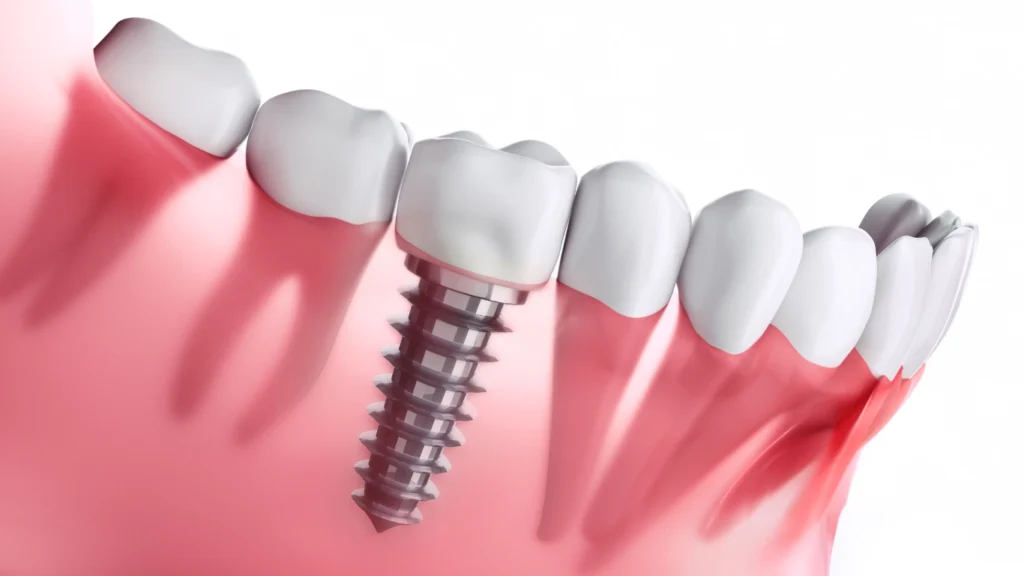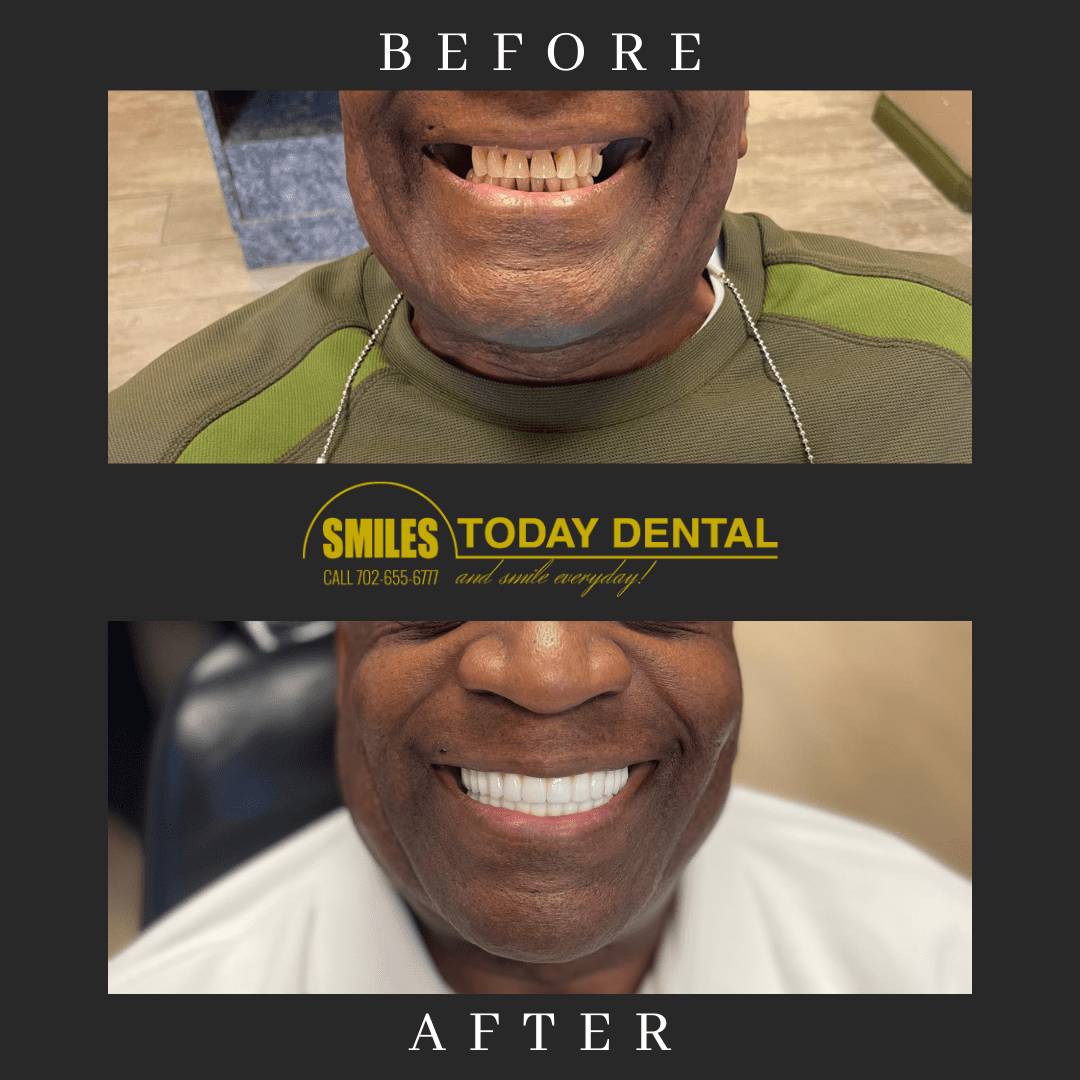Dental implants are artificial tooth roots made from titanium that are inserted into your jawbone to support replacement teeth. They look and function like natural teeth, providing a stable and long-lasting solution for missing teeth. In this article, you’ll learn more about what are dental implants, the types, procedures, and benefits of dental implants.
Key Takeaways
Dental implants serve as artificial tooth roots, providing a durable and stable foundation for replacement teeth while mimicking the function of natural tooth roots and preventing bone loss.
There are three primary types of dental implants: endosteal, subperiosteal, and zygomatic, each designed for different anatomical conditions and bone densities.
The dental implant procedure involves multiple stages, including consultation, surgical placement, and crown attachment, with a focus on osseointegration and careful planning to ensure long-term success.
Understanding Dental Implants
Dental implants are a modern marvel in the field of implant dentistry, designed to replace missing teeth and restore both function and aesthetics. Essentially, a dental implant is a prosthesis that supports a dental prosthetic or acts as an orthodontic anchor. They serve as artificial tooth roots, providing a stable foundation for replacement teeth that replaces teeth look, feel, and function like natural teeth.
The process of dental implant placement involves the insertion of a titanium post into the jawbone. This titanium post integrates with the bone over time, a process known as osseointegration, ensuring that the implant remains stable and functional. The stability offered by dental implants is unparalleled; they do not slip or make noise like dentures, and they do not cause bone damage as some bridges might.
One of the most compelling aspects of dental implants is their ability to mimic the function of natural tooth roots. Their integration with the jawbone helps preserve bone structure, preventing the typical bone loss that follows tooth loss. This not only maintains the shape of your face but also contributes to overall oral health, as the implants support the remaining teeth and prevent them from shifting out of place.
How Dental Implants Function
Dental implants work by being placed directly into the jawbone, providing a stable base for artificial teeth. Once the implants are in place, they undergo a healing process called osseointegration. This involves the bone growing around the implant, facilitated by the biocompatible titanium material used in most dental implants. This process is crucial as it ensures that the implant is securely anchored, much like a natural tooth’s root.
The success of dental implants relies on several factors, including the density and health of the jawbone, as well as the overall health of the patient. Unlike dental bridges and dentures, dental implants do not need to be removed and help preserve the jawbone structure. This not only prevents bone loss but also maintains the integrity of the facial structure, preventing the sunken look that often accompanies tooth loss.
In addition to their stability, dental implants offer the advantage of preserving the neighboring teeth. Traditional dental bridges require the adjacent teeth to be ground down to support the dental bridge, whereas dental implants do not compromise the integrity of the surrounding teeth. This makes them a more conservative and long-lasting solution for replacing missing teeth.
Types of Dental Implants

Dental implants come in various types to cater to different patient needs. The three primary types are endosteal, subperiosteal, and zygomatic implants. Each type has its unique characteristics and is suited for different anatomical and clinical situations.
Endosteal implants are the most common and are placed directly into the jawbone at the implant site, while the surrounding tissues are considered during the procedure. Subperiosteal implants, on the other hand, are situated above the jawbone but beneath the gum tissue, making them ideal for patients with insufficient bone density.
Zygomatic implants are anchored in the cheekbone and are used for patients who have experienced significant bone loss in the upper jaw and facial bones.
Endosteal Implants
Endosteal implants are the most common type of dental implants and are typically used when there is enough healthy bone in the jaw. These implants are shaped like screws, cylinders, or plates and are surgically placed into the jawbone. Once they integrate with the surrounding bone, they provide a sturdy base for artificial teeth.
Endosteal implants require oral surgery to drill into the jawbone and insert the endosteal implant body. After the implant surgery, there is a healing phase during which bone healing occurs as the bone growth happens around the implant, ensuring its stability and strength. This process can take several months but results in a highly stable and durable solution for tooth replacement.
Subperiosteal Implants
Subperiosteal implants are designed for individuals with low bone density who may not be suitable candidates for endosteal implants. These short implants are placed on top of the jawbone but beneath the gum tissue and surrounding soft tissues, making them a good option for those with insufficient bone height.
The framework of subperiosteal implants includes protruding posts that support the artificial teeth without the need for direct jawbone insertion. This type of implant is particularly useful for patients who do not want to undergo bone grafting procedures to build up their jawbone.
Zygomatic Implants
Zygomatic implants are a specialized type of dental implant used when there is insufficient jawbone for traditional implants. These implants are anchored in the cheekbone (zygomatic bone) rather than the jawbone, providing a stable foundation for prosthetic teeth. They are typically used for patients who have experienced significant bone loss in the upper jaw.
These implants are longer than other types and are designed to reach the zygomatic bone securely. The placement of zygomatic implants is a more complex procedure and requires a high level of expertise from the dental professional.
The Dental Implant Procedure
The process of getting dental implants is a multi-stage journey that involves careful planning and precision. It generally unfolds in several stages, allowing for proper healing and integration with the bone. Each step is crucial to ensure the success and longevity of the implants.
The stages include the initial consultation, treatment planning, surgical placement of the implants, attachment of the abutment, and finally, the placement of the dental crown. This thorough approach ensures that the implants are securely integrated and function just like natural teeth.
Initial Consultation
The initial consultation is the first step in the dental implant procedure. During this visit, healthcare professionals assess your oral health and discuss the possibility of dental implants. They will review your medical history and take dental X-rays to determine if you are a suitable candidate for the procedure.
For endosteal implants, it is essential to have enough bone to support the implant. The dental professional will evaluate the condition of your jawbone and discuss any additional procedures that may be necessary, such as bone grafting, to ensure successful implant placement.
Treatment Planning
Treatment planning is a critical phase that involves tailoring the dental services, dental implant procedure, and surgical procedure to your specific needs. The plan will outline the procedures, risks, benefits, alternative options, and anesthesia choices.
The dental professional will consider your specific health conditions and treatment preferences to develop a customized plan. If there is severe bone loss, a bone graft may be recommended to build up the bone and provide a stable foundation for the implant.
Surgical Placement of Implants
The surgical placement of dental implants is a crucial step in the process of dental implant surgery. It involves several stages, starting with rinsing the mouth with chlorhexidine to ensure cleanliness. If necessary, existing teeth are removed through tooth extraction, and a bone graft may be performed to prepare the jawbone for the implant.
Once the jawbone is ready, the dental professional will drill holes into the bone to place the implant body. The procedure is typically performed under local anesthesia, ensuring minimal discomfort for the patient. The entire process usually takes about 1 to 2 hours per implant.
After the implant is placed, the healing process begins. The bone needs time to integrate with the implant, a process that can take approximately 3 to 6 months. This healing phase is crucial for the stability and longevity of the dental implant.
Abutment Attachment
After successful integration, the abutment is attached to the implant to connect the implant and crown, ensuring stability.
This minor surgery involves reopening the gum to expose the implant and attach the abutment.
Crown Placement
The final step involves placing the dental crown. An impression is taken, capturing neighboring teeth and the abutment, and considering color to ensure the new artificial tooth blends seamlessly with the artificial tooth.
Fabricated in a dental office or dental lab, the dental crowns are attached to the abutment once the gums heal, using either a screw or cement.
Benefits of Dental Implants
Dental implants offer numerous benefits that make them a preferred choice for tooth replacement. They provide a stable foundation for artificial teeth, allowing for improved speech and comfort compared to traditional dentures. Unlike dentures, dental implants offer a stable hold and a natural appearance, resembling real teeth.
One of the significant advantages of dental implants is their durability. With proper care, dental implants can last a lifetime, making them a cost-effective long-term solution for tooth replacement. They also enhance chewing function, allowing you to eat a variety of foods without discomfort.
By preserving facial structure and preventing bone deterioration, dental implants maintain overall oral health. They support nearby teeth, preventing them from shifting. The materials used in dental implants, such as titanium, are chosen for their compatibility with human bone and resistance to decay.
Potential Risks and Considerations
While dental implants offer numerous benefits, there are potential risk factors and considerations to be aware of. Dental implant failure can be influenced by factors such as the quality and quantity of the surrounding bone. Conditions like diabetes can hinder the osseointegration process, leading to higher rates of implant failure.
Smoking significantly increases the risk of complications by negatively impacting healing. Poor oral hygiene can lead to peri-implantitis, an inflammatory condition that can result in implant failure, excessive bleeding, and periodontal disease. It’s essential to follow good oral hygiene practices and avoid smoking to reduce the risk of complications.
Alternatives to Dental Implants
There are several teeth alternatives to dental implants, including dental bridges, removable dentures, and implant-supported dentures. Unlike bridges, dental implants do not compromise adjacent teeth, preserving their integrity.
Flipper dentures offer a temporary, removable denture solution for missing teeth and lost teeth, including false teeth and removable prostheses, as well as for one missing tooth. People who wear dentures may find implant-supported dentures use implants for stable attachment, offering better support than traditional dentures.
Cost of Dental Implants
The cost of dental implants can vary based on geographical location and the expertise of the dental professional. Some dental insurance plans may offer coverage for the procedure, but this depends on individual policy details.
Financing options for dental implants often include payment plans offered by dental practices. Additional costs associated with dental implants can include consultations, imaging tests, and anesthesia.
Lifespan and Maintenance of Dental Implants
Dental implants offer a long-lasting solution, often lasting a lifetime with proper care. Good oral hygiene is crucial for maintaining dental implants, as plaque buildup can jeopardize their stability.
Daily oral hygiene habits, including brushing and flossing, are essential to maintain the integrity of dental implants. Regular follow-up visits after crown placement are essential for monitoring proper fit and healing.
Summary
In summary, dental implants are a revolutionary solution for replacing missing teeth, offering stability, durability, and a natural appearance. They function like natural tooth roots, preserving the jawbone and maintaining facial structure. The multi-stage procedure ensures a customized and successful outcome.
If you are considering dental implants in las vegas, consult with us at Smiles Today Dental. With the proper care and maintenance, dental implants can provide a lifetime of healthy smiles and improved quality of life.
At Smiles Today Dental, our experienced dental team is dedicated to providing exceptional care. Led by dental implant specialist Dr. Kerio, who has over 26 years of experience in various dental specialties, including several types of implants, our team ensures that every patient receives expert treatment. Our dental professionals have extensive experience in implant dentistry, enhancing the success and satisfaction of our treatments.
Before & Afters


FAQs About Dental Implants
Smiles Today Dental is dedicated to helping you regain your confidence with affordable, high-quality dental implants.
What is the success rate of dental implants?
The success rate of dental implants is typically between 95-98%, provided that proper oral hygiene is maintained and the procedure is conducted by a skilled dental professional. This high success rate underscores the effectiveness of dental implants in restoring dental function.
How painful is the dental implant procedure?
The dental implant procedure is typically associated with minimal discomfort during surgery, thanks to local anesthesia. Post-operative pain can usually be effectively managed with over-the-counter medications.
How long does it take to get dental implants?
The dental implant process typically takes several months, including 1-2 hours for the initial surgery and a healing period of 3-6 months before the final components are placed. It is essential to allow adequate time for proper healing to ensure the success of the implants.
Are dental implants covered by insurance?
Dental implants may or may not be covered by insurance, as this depends on the specific plan you have. It is crucial to consult with your insurance provider to clarify your coverage details.
Can anyone get dental implants?
Most individuals who have lost teeth can qualify for dental implants, provided they possess adequate bone density and maintain good overall health. Conditions such as uncontrolled diabetes or heavy smoking may hinder eligibility.




